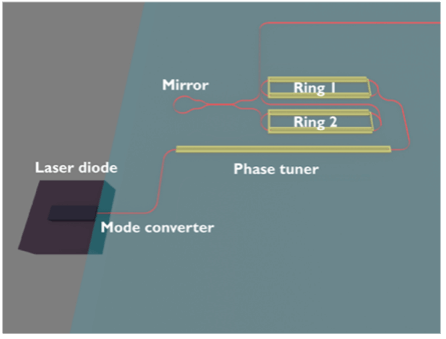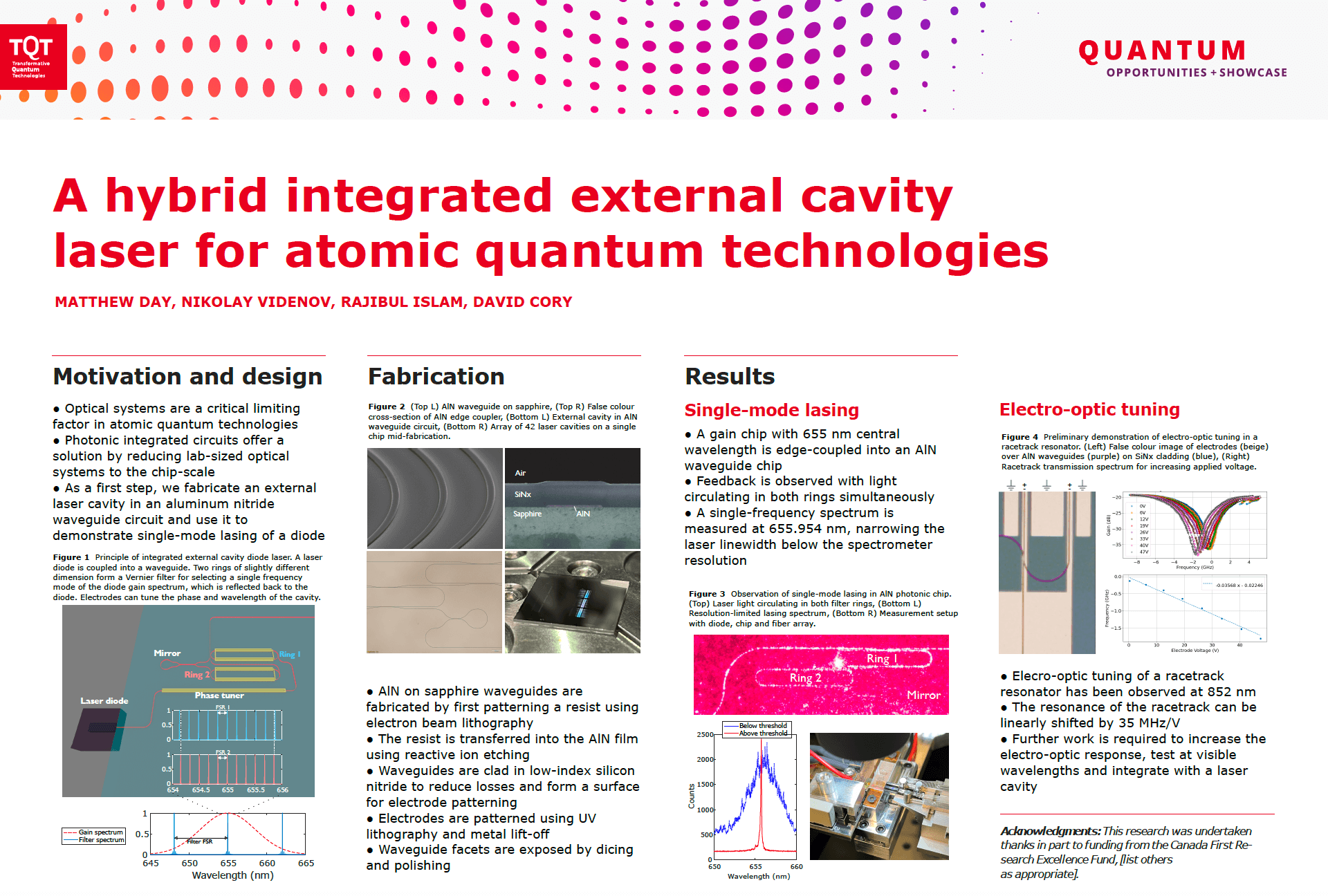Integrated external cavity lasers will enhance quantum atomic technologies
Photonic integrated circuits could reduce laser systems to chip-scale devices.
Cold atoms provide a powerful platform for the implementation of technological applications in quantum computing, sensing and communication. Electronic transitions in these atoms have very precise and particular wavelengths. Lasers that can be tuned to these exact wavelengths are required to manipulate the internal energy levels of these atoms, which allows for the preparation, control and measurement of quantum states required for quantum technological applications.
Current laser systems are bulky, expensive, and fragile. Dr. Matthew Day, a research associate at the Institute for Quantum Computing, leads a technology development project funded by TQT that aims to develop integrated photonics to enable the reduction of these optical sources by three orders of magnitude while increasing the reliability and functionality for quantum experiments: “By miniaturizing the optical circuitry needed to select these laser frequencies down to the chip scale, they can be made to be more compact, cheaper and robust. This would allow the ground-breaking demonstrations with cold atom systems in timing, sensing and computing to be brought out of the lab into products that can broadly impact society.”
A photonic integrated circuit (PIC) external cavity diode laser (ECDL) was fabricated using aluminum nitride (AlN). Most previous demonstrations of PIC ECDLs are offered in the infrared wavelength, whereas many atomic transitions of interest are in the UV and visible wavelength range. AIN is the ideal material for this application as its large bandgap allows for low-loss waveguide propagation at visible wavelengths. AlN also has electro-optic control for fast switching and tuning for preparing narrow linewidth and agile optical frequencies.
To create the PIC ECDL, a red wavelength laser diode was coupled to the AlN waveguide. Electrodes were patterned on the device for frequency and phase tuning. The system also consisted of a frequency-selective feedback cavity composed of a Vernier filter with micro-ring resonators. Ring resonators only accept light of a particular frequency, allowing them to be used as frequency-selective filters. The laser frequency could be tuned through an electric field applied to electrodes patterned over the resonators.

Figure: Artistic render of a hybrid external cavity diode laser. A laser diode is coupled into a waveguide. Two rings of slightly different dimensions form a Vernier filter for selecting a single frequency mode. Electrodes are used to tune the laser frequency by the electro-optic effect.
The researchers measured a single-frequency spectrum at 655.954 nm, showing that the red wavelength laser diode was locked to the frequency defined by the on-chip filter. Further, electro-optic tuning of the resonator was observed at 852 nm, successfully demonstrating that the filter can be tuned with an electric field, paving the way for tunable lasers on a chip. Further work is required to increase the electro-optic response, test at visible wavelengths and integrate with a laser cavity.
Once this integrated ECDL is fully developed, it can be further coupled into fibre optics for delivery to atoms in a vacuum chamber, demonstrating the viability of using tunable PIC ECDLs to interact with atomic energy levels. Reducing the laser systems to the chip scale would substantially enhance existing quantum experiments, enable experiments currently unviable with bulk optical setups and allow for the translation of quantum atomic technologies into practical settings. “These miniaturized tunable light sources enable applications where we want portability, such as quantum gravimeters or large-scale quantum computation and simulation, where many laser sources are required to address a large number of atoms. Beyond atomic quantum technologies, these laser sources at visible wavelengths could be used in coherent LIDAR environments where infrared light cannot be used, such as underwater, or where the object being targeted returns more useful information at visible wavelengths, such as measuring snow pack depths.”
This research was undertaken thanks in part to funding from the Canada First Research Excellence Fund.
_____________________________________________________________________________________________________________________________________

Poster: A hybrid integrated external cavity laser for atomic quantum technologies
Poster authors: Matthew Day, Nikolay Videnov, Rajibul Islam, David Cory
